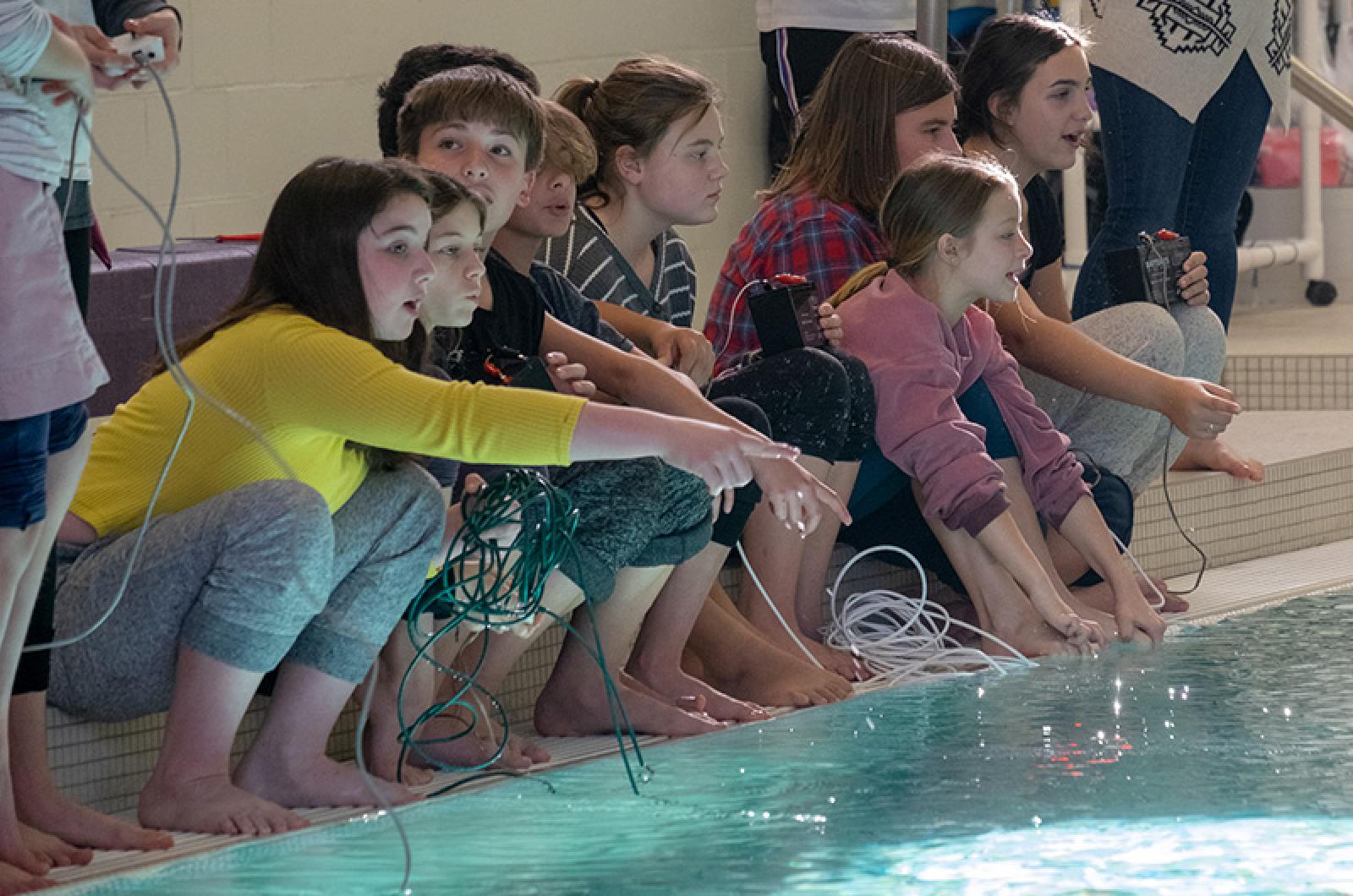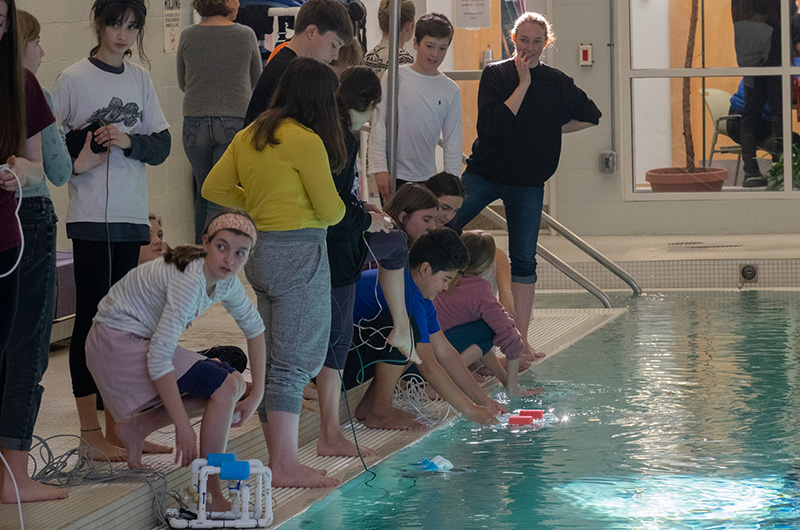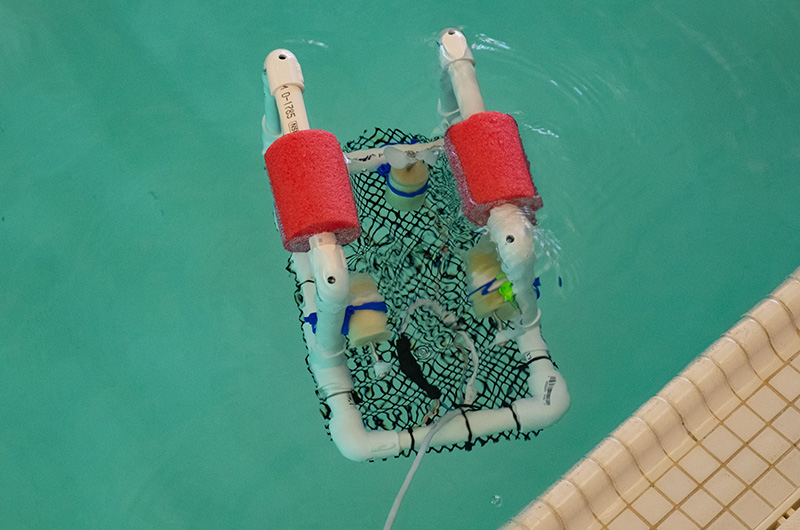On Wednesday, Island middle school students hurried off the bus and lined the pool of the YMCA eager to plunge their remote operated vehicles into the chlorinated water for their first trial runs. The underwater robots were constructed with PVC piping, pool noodles, wire mesh, mini propellers and a control board the students built by learning how to solder.
The event was the culmination of eight weeks of work supervised by Megan Carroll, a research engineer at the Woods Hole Oceanographic Institution. Ms. Carroll helped the students build miniature models of the submarines the Oceanographic Institution uses for ocean exploration.
Working in teams of three, students from the Martha’s Vineyard Public Charter School and the Vineyard Montessori School operated their vehicles as a group. One member of the team would launch their submersible while one of their classmates was in charge of keeping the power cord tethered to their project from tangling. The last member of the group captained the vessel.
Bobby Joe Cook, a sixth-grader at the charter school, said his favorite thing about the project was “building the controller. It was pretty cool.”
Floyd Hershey liked creating the control center, and Winter Muric said she enjoyed learning the soldering process. “There was smoke coming out of it. It was hard to build because the holes are so tiny.”
Casey Hayward, a science teacher at the charter school, said she had shown her class videos of different types of remote operated vehicles and aquatic underwater vehicles. In particular, Ms. Hayward said her students were interested in the shark cameras used for Great White Shark research and the jetyak which Woods Hole developed to study glaciers.
“Anytime you can embed learning in hands-on activities we get a positive reaction from the kids,” Ms. Hayward said. “They don’t even realize they’re learning because they’re having fun. But they’re using practical math skills, practical science, they’re working as a team, it’s great.”
Megan Carroll graduated from the regional high school in 1995. She said when she was a kid growing up on the Vineyard with an interest in science, the technology hadn’t advanced to the point where she could have hands-on experiences in her field of interest. For the past three years, she has been running a week-long summer camp at the Edgartown School where kids have had the opportunity to build similar submersible vehicles.
“I thought it would be really cool to get kids more experience in real-world situations because I know I would have benefited from that,” she said. “So much is changing now and really giving these kids the opportunity to engage with real-world applications and see what else there is and what they can do with the resources they have available to them is important.”
In her time working at the Oceanographic Institute Ms. Carroll has sailed off the west coast of the United States on the R/V Atlantis Astoria where she observed Alvin dive operations. She has also sailed on the R/V Cape Hatteras off Puerto Rico where she worked on coral reef mapping with an AUV.
While working with the students she shared her experiences, both the exciting and the difficult.
“If something doesn’t work, I don’t want them to be discouraged and become disheartened in what they’re doing,” she said. “We’re going to figure out why it’s not working and what we can do to correct it. Allowing the kids to do it on their own, I believe, helps build their confidence and their skills.”
Grace Bennett-Rock, also a sixth-grader at the charter school, was excited about the possibilities that her remote operated vehicle could be used for. “I think it’s really cool that these could go into the ocean with a camera to see what we can’t see,” she said.
Soon Ms. Carroll will begin working with a group of seventh grade charter school students and lead an after-school program at the West Tisbury School. She said there is an annual competition where students modify their remote operated vehicles to complete an obstacle course. Each year brings a new mission to the obstacle course and this year’s mission is waterways cleanup. So, in addition to guiding their vehicles through PVC hoops and de-activating mines, there will be a garbage patch of floating debris students have to collect and dump into a disposal vault.
“It’s a little more advanced, so I’m hoping to build it up, get students interested and form a team,” Ms. Carroll said. “We’d like our students to participate in that, get off the Island and meet other students to see what they are building. There are different levels you can participate in, middle school all the way through college. Then you can take it to the next level.”








Comments
Comment policy »